The next-gen MacBook Pro with Retina Display Review
by Anand Lal Shimpi on June 23, 2012 4:14 AM EST- Posted in
- Mac
- Apple
- MacBook Pro
- Laptops
- Notebooks
Last year when I wrote about the new MacBook Airs I offered two forward looking paragraphs:
What happens from here on out is what's really interesting. Intel has already committed to moving the TDP of its mainstream parts from 35W - 45W down to 10 - 20W. Since the Air is the new mainstream Mac notebook, Apple has already made that move. The performance in this 10 - 20W segment is going to get much better over the next two years, particularly once Haswell arrives.
The Thunderbolt Display is the first sign of what's to come. Moving IO controllers and expansion into the display, and potentially even moving discrete GPUs out of the notebook are all in store for us. Apple is really ahead of the curve here, but it's easy to imagine a future where laptops become a lot more like the new Air and shift to a couple high bandwidth ports instead of numerous lower bandwidth connections.
Perhaps I was being too aggressive in the prediction of a couple of high bandwidth ports. After all, the next-generation MacBook Pro with Retina Display features four such IO ports (2 x Thunderbolt and 2 x USB 3.0). But you get my point. Gigabit Ethernet and Firewire 800 are both gone. The discrete GPU is still present but I suspect even its days are numbered, at least inside the chassis. The personal computer as we knew it for so long, is changing.
The personal computer is getting thinner, lighter, more integrated and more appliance-like. The movement is no longer confined to just Apple either. The traditional PC OEMs are following suit. Even Microsoft has finally entered the PC hardware business, something it threatened to do for years but hadn't until now. Distribution models will change, the lines between different form factors will continue to blur. What was once a mature industry is going through a significant transformation. It’s exciting but at the same time it makes me uneasy. When I first got into this industry everyone had stories of companies with great ideas that just didn’t make it. As we go through this revolution in computing I’m beginning to see, first hand, the very same.
Apple makes the bulk of its revenue from devices that don’t look like traditional personal computers. For the past couple of years I’ve been worried that it would wake up and decide the traditional Mac is a burden, and it should instead be in the business of strictly selling consumer devices. With its announcements two weeks ago in San Francisco, I can happily say that my fears haven’t come true. At least not yet.
It’s been a while since Apple did a really exciting MacBook Pro launch. Much to my surprise, even the move to Sandy Bridge, the first quad-core in a MacBook Pro, was done without even whispers of a press conference. Apple threw up the new products on its online store, shipped inventory to its retail outlets, updated the website and called it a day. Every iPhone and iPad announcement however was accompanied with much fanfare. The MacBook Pro seemed almost forgotten.
With its WWDC unveil however Apple took something that it had resigned to unexciting, dare I say uncool status, and made a huge deal about it. Two weeks ago Apple did the expected and offered relatively modest upgrades to all of its portable Macs, all while introducing something bold.
Apple calls it the MacBook Pro with Retina Display. You’ll see me refer to it as the next-gen MacBook Pro, Retina MacBook Pro, rMBP or some other permutation of these words.
After using it for the past two weeks I can honestly say it’s the best Mac Apple has ever built. And there’s a lot more to it than hardware.
Portability
If you were hoping for a 15-inch MacBook Air, that’s not what the rMBP is. Instead it is a far more portable 15-inch MacBook Pro. I have to admit I was a bit let down the first time I laid eyes on the next-gen MacBook Pro, it looks good but it doesn’t look all that different. The disappointment quickly faded as I actually picked up the machine and started carrying it around. It’s not ultra light, but man does it make the previous chassis feel dated.
While I never really liked lugging around the old MBP (and it always made me feel like the old fogey at tradeshows where everyone else had something 13-inches or smaller), carrying the rMBP is a pleasure by comparison. Pictures really don’t do it justice. The impressively thin display assembly or overall chassis thickness look neat in a photo but it’s not until you actually live with the rMBP that you can appreciate what Apple has done here. I carry around a 15-inch MacBook Pro because it’s my desktop, and as such it’s incredibly useful to have with me when I travel. For my personal usage model, the Retina MacBook Pro is perfect.
If your workload demands that you need the performance of a MacBook Pro and your lifestyle requires you to carry it around a lot, the reduction in thickness and weight alone will be worth the upgrade to the rMBP. If you spend most of your time stationary however, you’ll have to be sold on the display and internal characteristics alone. The bad news is if the design doesn’t get you, everything else will.

From left to right: 11-inch MacBook Air, 13-inch MacBook Air, 15-inch MacBook Pro, MacBook Pro with Retina Display
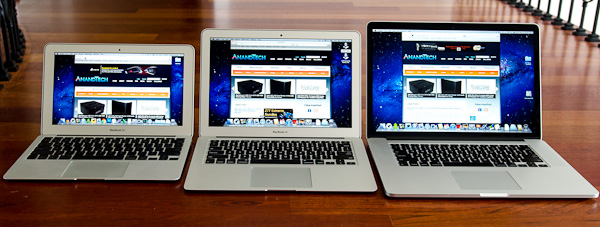
From left to right: 11-inch MacBook Air, 13-inch MacBook Air, MacBook Pro with Retina Display
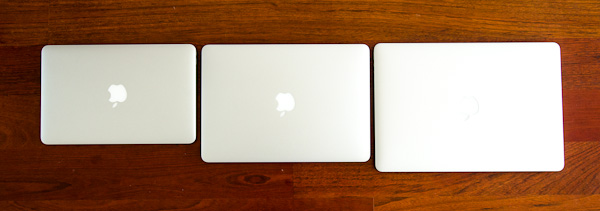
From left to right: 11-inch MacBook Air, 13-inch MacBook Air, MacBook Pro with Retina Display


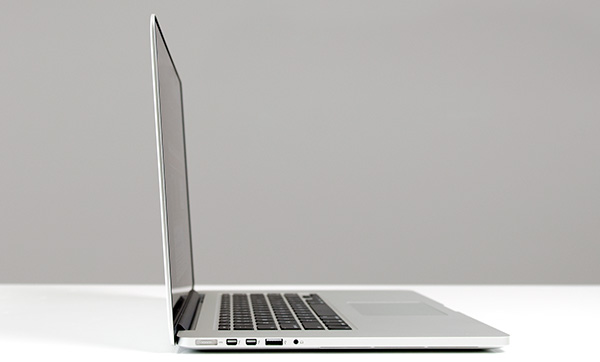
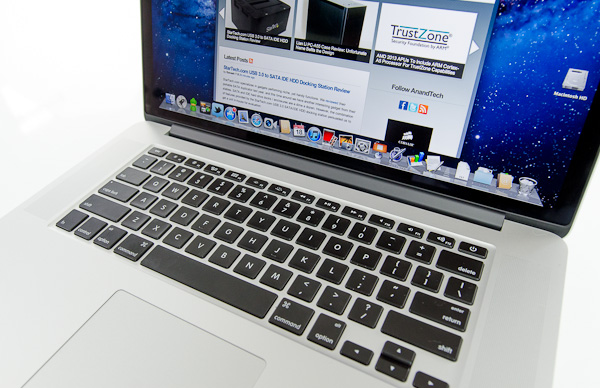
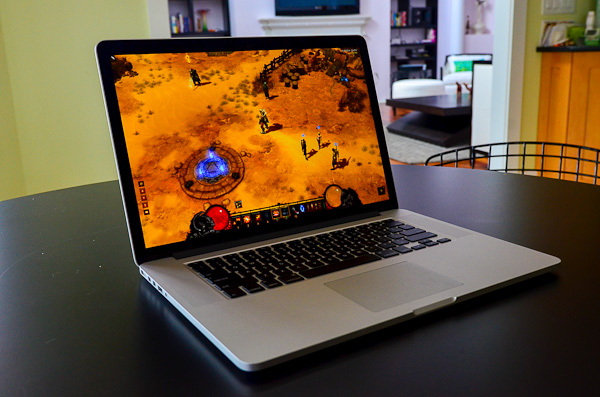
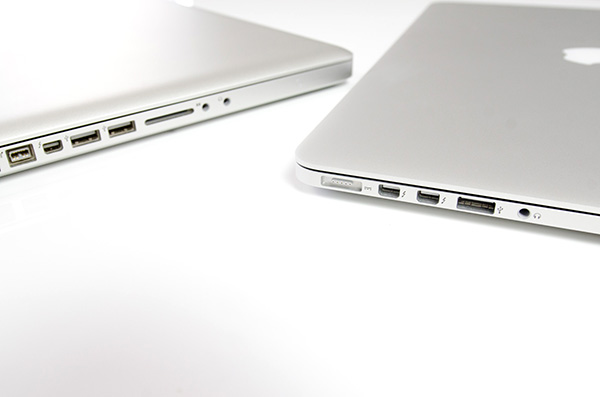
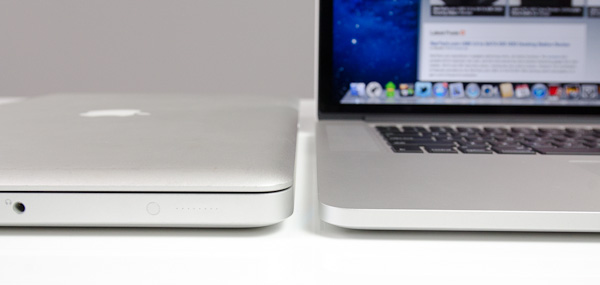








471 Comments
View All Comments
netmann - Saturday, June 23, 2012 - link
Anand, very nice review as always! One picture I was hoping to see is the location of exhaust vents on rMBP. Are the vents similar to MacBook Air discharging hot exhaust air towards the hinge, or are the vent similar to Asus Zenbooks exhausting the hot air through angled grille towards the screen? ThanksMarburg U - Saturday, June 23, 2012 - link
Customers really didn't care about displays.Customers have always payed attention or tho the price or to the brand (and that's an exlusive or). And they are doing the same right now. And they will continue doing so in the future.
I've never bought an Apple product. But i will always be thankful to Apple because they make niches profitable and transform those tiny places in big markets.
tipoo - Saturday, June 23, 2012 - link
It's now known this is the first MBP that can use three external displays via the two TB ports and HDMI. However I'm a bit sceptical as this review says things can get choppy even just on its own one display, I'm curious how it does with four.kidconcept - Saturday, June 23, 2012 - link
"The GT 650M is fast enough to drive the rMBP’s 2880 x 1800 panel at native resolution at playable frame rates, around 18 fps on average." (Concerning Diablo 3)I understand that gaming performance is not a concern for most people purchasing the macbook pro, but I think the review of the GPU is downright misleading. The review glosses over higher performance GPU's available on the market, and fails to identify the 650 as a middling performance current gen GPU. The benchmarks are all against older generation GPU's from previous apple products and all in games that aren't demanding performance-wise. What's missing is the top end of the chart and it gives a misleading perspective on the capabilities of this machine.
Don't get me wrong, I would love to own one of these devices. But I think that if you happened to wander in to buying a rMBP hoping to get good gaming performance, you are going to be disappointed.
wfolta - Saturday, June 23, 2012 - link
The quote you have from the article addresses exactly your point. The rest of the GPU info is for people who would be comparing this to previous models, while the quote addresses game playing. As you say, the primary audience for this machine is not hardcore gamers.The 650 is "middling" only compared to chips that appear in gaming laptops that generally weigh twice as much and are twice as thick as the rMBP, which means they're simply not comparable machines.
I'd add that in Diablo III, Normal Act III, I'm getting 20 FPS when battling a few dozen mobs, and more than that otherwise. That's with most settings turned up (I think a couple default to "Medium"), 2880x1800 with AA. I haven't had a chance to experiment with using a lower resolution (1440x900) without AA, but I've read that frame rates to increase substantially. Not bad for an ultrabook.
sheh - Saturday, June 23, 2012 - link
Would be interesting to know how fast the display is. Pixel response times, lag, RTC, etc.frabber - Saturday, June 23, 2012 - link
Given that Lenovo ships with 170W for "similarly" equiped w530 (cpu 3720qm, gpu k2000m) ?Is that 85 watt really sufficient, how does that work?
umesh - Saturday, June 23, 2012 - link
The price for the higher end rMBP is $ 2799, and not $ 2699 as given in the article.Ryan Smith - Saturday, June 23, 2012 - link
Not sure how that ended up in there...Thanks for the heads up. Fixed.
name99 - Saturday, June 23, 2012 - link
"Perhaps I was being too aggressive in the prediction of a couple of high bandwidth ports. After all, the next-generation MacBook Pro with Retina Display features four such IO ports (2 x Thunderbolt and 2 x USB 3.0). But you get my point. Gigabit Ethernet and Firewire 800 are both gone. "You were too aggressive, but I think the point remains, and remains valid. I look at the rMBP and what strikes me ("irritate" is too strong) is the existence of the HDMI port --- I don't want that and would rather have a 3rd USB3 port or TB port. And I think this is everyone's feeling --- you MUST have an HDMI port, the guy over there MUST have an ethernet port.
If we could get to the point where
- the device comes with 4TB ports,
- a large number of reasonably priced TB devices exist, and
- a rich set of backward adapters exist (like the, IMHO reasonably priced, Apple ethernet adapter)
we'd all be better off.
Personally I have no idea what Apple and Intel thought would be usefully achieved by keeping TB Apple exclusive for a year, but now that that's over, it will be interesting to see how this plays out.
I do think the path the rMBP has taken (no ethernet, but LOTS of IO available in principle, and with Apple showing how that is useful for ethernet) is a good start, and makes the rMBP that much more desirable a machine --- almost a laptop with slots. But the PC vendors are all in such a screwed up state these days --- making no profit competing with Apple, terrified that MS is stealing their business, uncertain where Android is going --- that I fear none of them is willing to do anything aggressive to try to compete with Apple in this space. Will we see a high end Lenovo or Sony machine that tosses its obsolete ports for TB? Hmm. Given that these vendors seem to believe it makes sense to retain the VGA port, I suspect not.
The lack of TB hubs, for example, strikes me as a real problem. (To the extent that if I were Apple or Intel, with a strategic interest in pushing this technology I'd be selling my own --- 3rd party vendors have been given over a year to step up to the plate and have not delivered.)